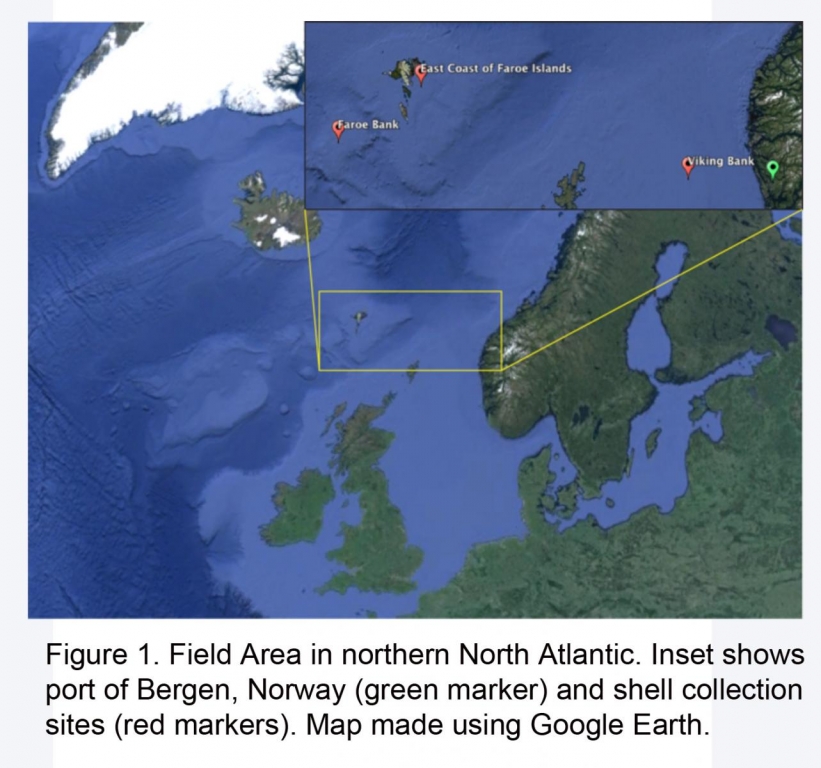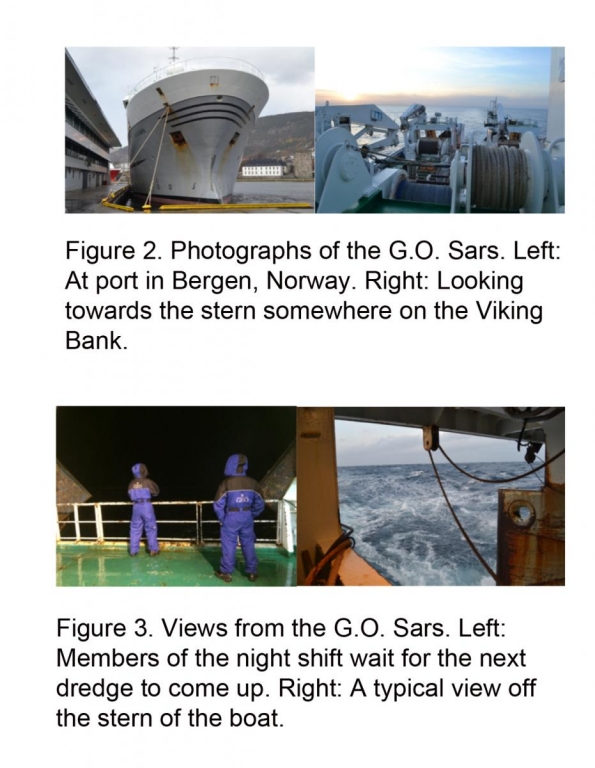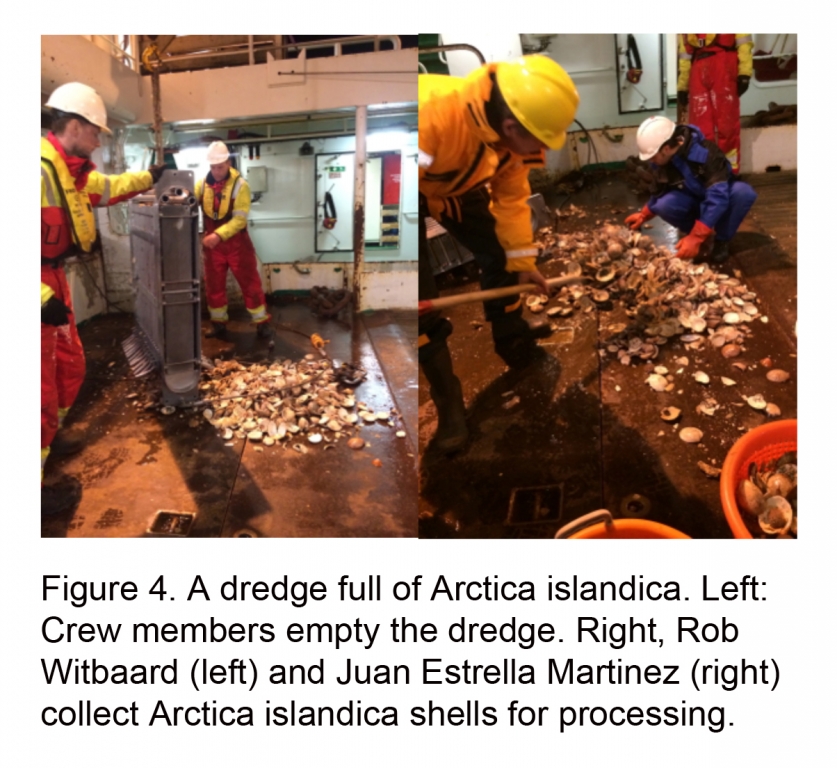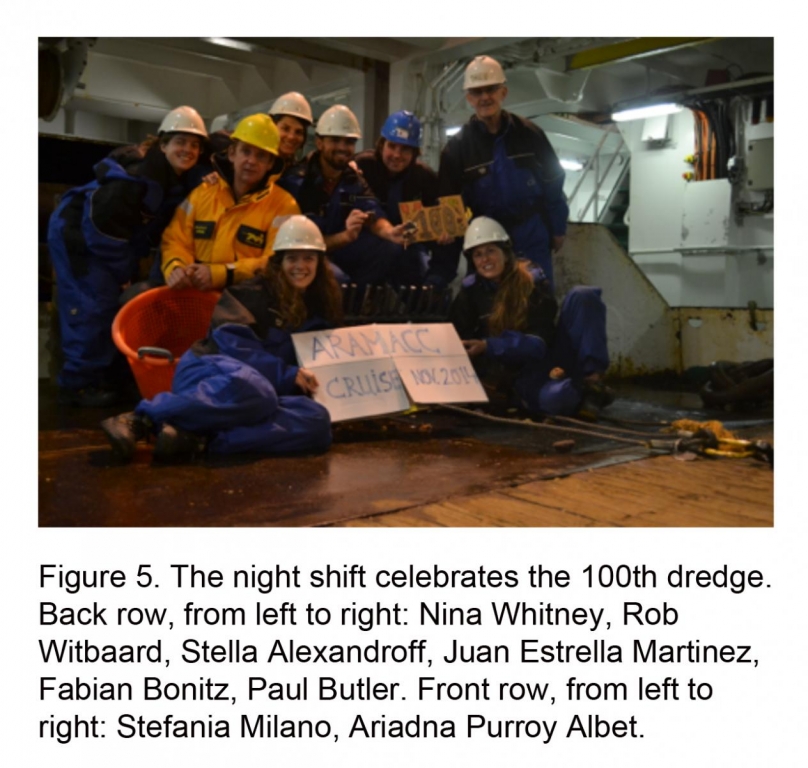Determining North Atlantic Hydrographic Variability near the Faroe Islands and the Viking Bank using Arctica Islandica Shells
Determining North Atlantic Hydrographic Variability near the Faroe Islands and the Viking Bank using Arctica Islandica Shells
Field Team Members: Nina Whitney1, Carin Andersson Dahl2,3, Paul Butler2,4, Bernd Shone2,5, Rob Witbaard2,6 Ariadna Purroy Albet2,7, Stella Alexandroff2,4, Irene Ballesta Artero2,6, Fabian Bonitz2,3, Amy Featherstone2,8, Juan Estrella Martinez2,4, Stefania Milano2,5, Maria Pyrina2,9, Tamara Trofimova2,3, Liqiang Zhao2,5, Alejandro Roman Gonzalez10
1) Climate Change Institute, University of Maine, Orono, Maine; 2) Annually Resolved Archives of Marine Climate Change (ARAMACC) project; 3) Uni Research, Bjerknes Centre for Climate Research, Bergen, Norway; 4) School of Ocean Sciences, Bangor University, Bangor, Wales; 5) Institute of Geosciences, Johannes Gutenberg University, Mainz, Germany; 6) Marine Ecology Department, Royal Netherland Institute for Sea Research, Texel, the Netherlands; 7) Institute of Oceanography and Fisheries, Split, Croatia; 8) Université de Bretagne Occidentale, Brest, France; 9) Institute of Coastal Research, Helmholtz Zentrum Geesthacht, Geestacht, Germany, 10) School of Earth and Ocean Sciences, Cardiff University, Cardiff, Wales
Field Dates: November 8-16, 2014
Field Site: Northern North Atlantic
Introduction
In order to better understand today’s changing climate and model future climate, it is pertinent to understand climate variability and influences in the past. To this end, much work has been done on identifying biological and geological proxies that act as physical and chemical indicators of past climate. One such proxy in the North Atlantic is the argonitic shell of the long-lived mollusk Arctica islandica. The shells of Arctica islandica grow in annual increments and thus constitute one of the few annually resolved marine climate proxies in the North Atlantic outside of the tropics (Schöne, 2013). Recent work at the University of Maine has used Arctica islandica shells collected from the Gulf of Maine to construct a chronology that dates to 1694. Oxygen isotopes measured from shells cross-dated into this chronology are being used to reconstruct records of seawater temperature and salinity in the Gulf of Maine. Similar work is being conducted in Europe through the European Union funded program Annually Resolved Archives of Marine Climate Change (ARAMACC). The recent research cruise taken on the R/V G.O. Sars out of Bergen, Norway was for the primary purpose of collecting Arctica islandica shell material for two Ph.D. projects in the ARAMACC program that are seeking to build annually resolved shell based chronologies for the Faroe Islands and Vikings Bank, Norway in order to reconstruct hydrographic variability in the northern North Atlantic. This research cruise not only provided the opportunity for all students involved to gain experience collecting and processing Arctica islandica shells but it also provided the opportunity for networking between the University of Maine and the ARAMACC program, which will set up future collaboration between scientists working on Arctica islandica shells on both sides of the North Atlantic.
Field Report
Using funding from the Churchill Exploration Fund, I flew from Bangor, Maine to Bergen, Norway in early November, 2014 where I met up with ARAMACC professors and students. On November 8th, we boarded the research vessel the G.O. Sars (Figure 2), which is used by the Institute of Marine Research and the University of Bergen for various research cruise expeditions. It took 30 hours to steam out to our first dredging site, which was on the east coast of the Faroe Islands. After collection was finished here (see below for details), we steamed west to the other side of the Faroe Island and the Faroe Bank. Unfortunately, due to rough waters and an approaching storm, we were only able to do a couple dredges at this location before we were forced to steam east. Our final collection location was on the Viking Bank off the coast of Norway.
While at each location, students and professors were split into two groups, each group having two six-hour shifts a day. The majority of the time spent at each location was devoted to dredging the ocean floor for Arctica islandica shells (Figure 3). Each dredge usually lasted for six minutes at a time. Any Arctica islandica shells pulled up in the dredge would be collected by shift members, cleaned, measured, weighed and given sample numbers before being stored.
Each location was dredged in a grid-like pattern. At most new locations, shift members used echo sounding to ensure that there were no large obstacles on the ocean floor that would damage the dredge before dredging commenced. Dredges would sometimes produce only mud and rocks, while at other times a single dredge would contain hundreds of Arctica islandica shells (Figure 4). During these times, only the live and articulated (indicating recently dead) shells were processed. The dead unarticulated shells were washed and stored, to be processed later. On occasion, we also took CTD (conductivity, temperature and depth) profiles of the water column and collected water samples for other research done at the University of Bergen.
While exact numbers are not currently known to me, I would estimate we collected well over 5,000 dead Arctica islandica shells and over 500 live-caught Arctica islandica shells in over 100 dredges during the research cruise (Figure 5). This will provide a significant amount of material for constructing annually resolved shell-based chronologies in the North Atlantic and reconstructing hydrographic variability in the region. In addition to collecting Arctica islandica shells, we also collected several dozen Glycimeris glycimeris, another North Atlantic mollusk that several ARAMACC students are studying for their Ph.D research. Additionally, we caught a large variety of bycatch, including sting rays, monk fish, octopus, hermit crabs, starfish, anemones and snails, which were all thrown back into the ocean.
Conclusion
Participation in this research cruise, which was made possible by a grant from the Churchill Exploration Fund, provided me with numerous valuable opportunities. Having not previously had the chance to participate in the collection of Arctica islandica shells, since all of the material for my graduate research had been collected prior to my start at the University of Maine, this research cruise provided me with the opportunity to be involved in every aspect of that collection process, from monitoring potential collection sites for dredging hazards to the actual collecting and processing of the shells. Additionally, being able to meet and work with other early career researchers and well as some of the top research scientists in the field of sclerochronology (the study and dating of accretionary hard parts of organisms, such as shells) introduces the exciting possibility of collaboration on future research projects and provides me with a wealth of resources as I continue to advance my career in climate science and sclerochronology.
Acknowledgements
I am very grateful to the Dan and Betty Churchill Exploration Fund for providing the funding that made it possible for me to participate in this research cruise.
References
Schöne, B. R., 2013, Arctica islandica (Bivalvia): A unique paleoenvironmental archive of the northern North Atlantic Ocean: Global and Planetary Change, v. 111, p. 199-225.





